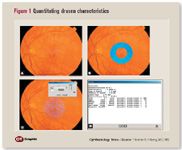Article
Baseline drusen area, pigment abnormalities help predict AMD events
Two baseline characteristics-drusen area and pigment abnormalities-are associated with the development of advanced age-related macular degeneration.

Key Points

In a study conducted at the University of Pittsburgh Ophthalmology and Visual Science Research Center, investigators found that two baseline characteristics-drusen area and pigment abnormalities-were associated with the development of advanced AMD, according to Maria Palaiou, MS, data manager and clinical coordinator at the University of Pittsburgh Medical Center ophthalmology department. She presented the study's results at the annual meeting of the Association for Research in Vision and Ophthalmology, Fort Lauderdale, FL.
In all the models used in this study of nearly 1,000 eyes, pigment was a statistically significant and important risk factor. Drusen area was positively associated with the probability of a choroidal neovascularization (CNV) event but the results were inconclusive for the time to a CNV event. The investigative team also found that visual acuity decreased as the typical subject aged, decreased with increased drusen area, and decreased in the presence of pigment.

The main emphasis of this project was to perform a more robust quantification of drusen and other morphologic characteristics, taking advantage of the information within each digital image, explained Dr. Friberg. He noted that historic methods using measuring templates are more time-consuming and yield results that are less precise and potentially less accurate. "Drusen analysis may yield useful predictive information that is relevant to the patient," Dr. Friberg said.
Palaiou and her colleagues developed statistical predictive models. Logistic regression analysis was used to determine the probability of a CNV event occurring based on baseline characteristics; generalized estimating equations were used to account for clustering of subject eyes. This analysis was performed only on patients from AREDS. The time to a CNV event was analyzed (using patients from both clinical trials) by means of a failure time model (survival analysis with frailty). Longitudinal mixed effect models (using patients from both clinical trials) were used to model visual acuity as a function of drusen area, pigment, baseline age, and follow-up time.
Drusen, pigment analyzed
Investigators evaluated the following variables to determine CNV events:





